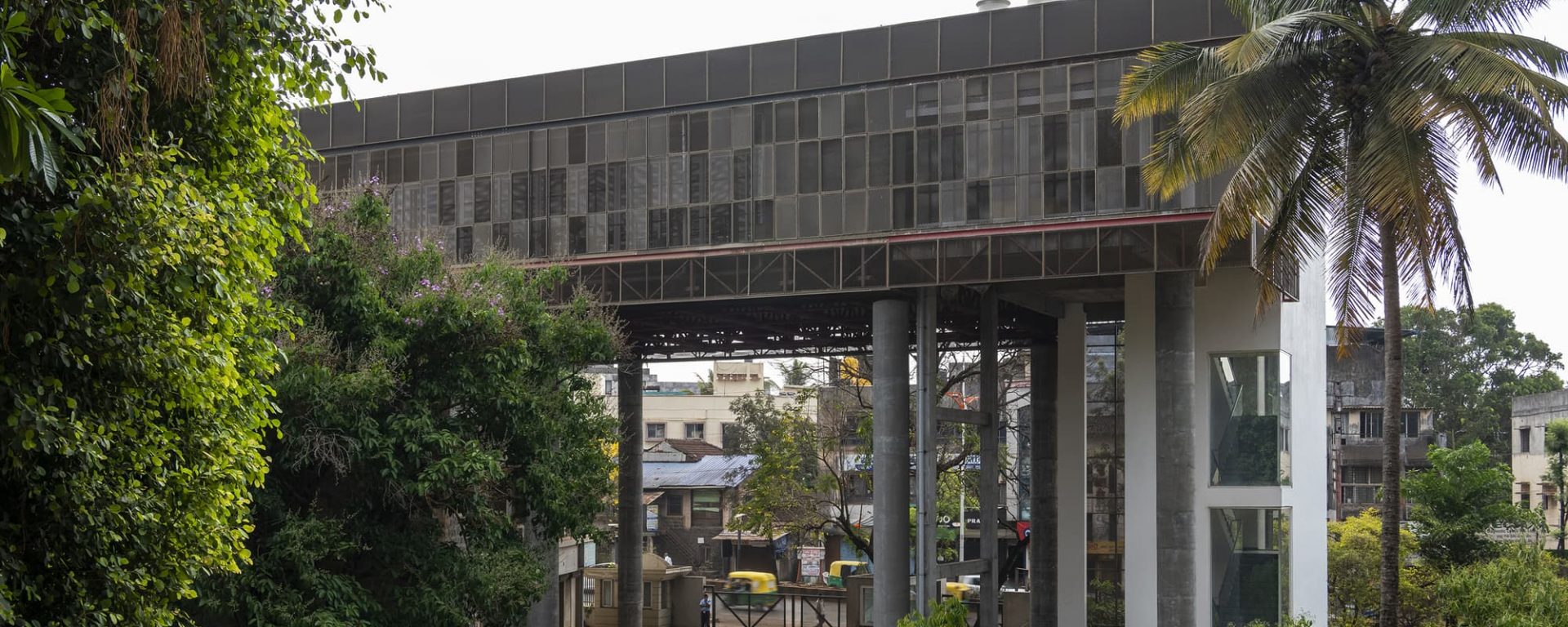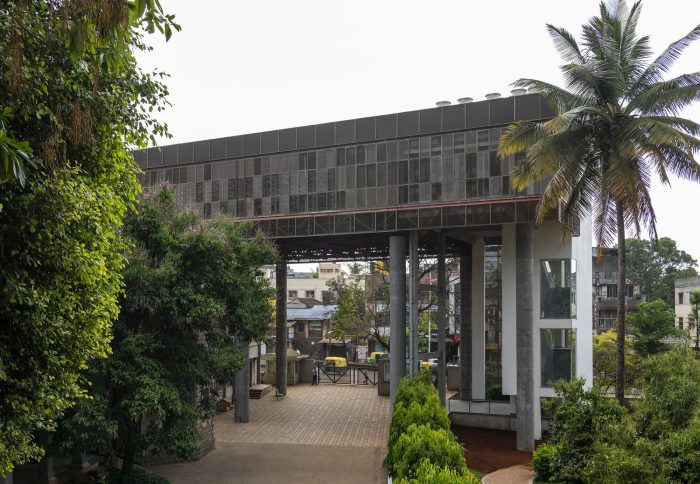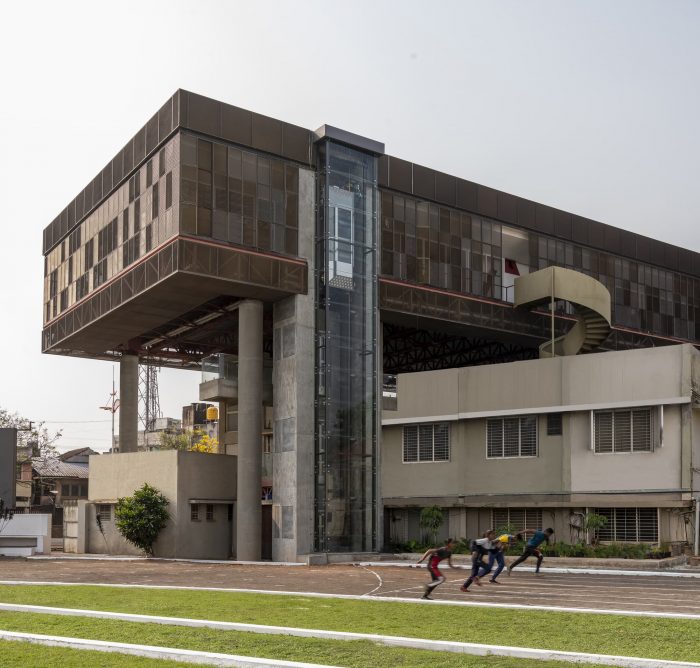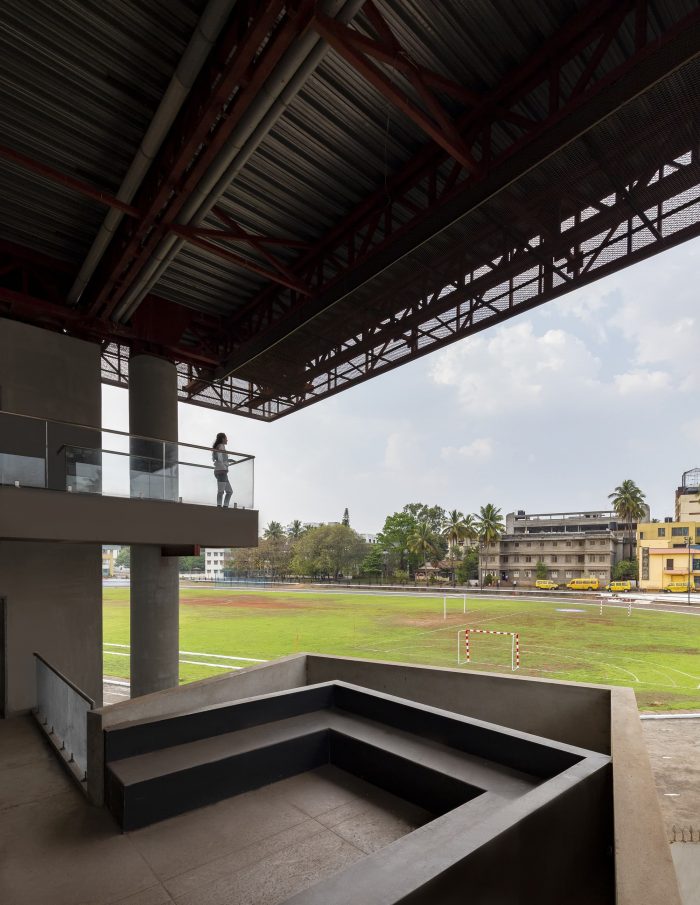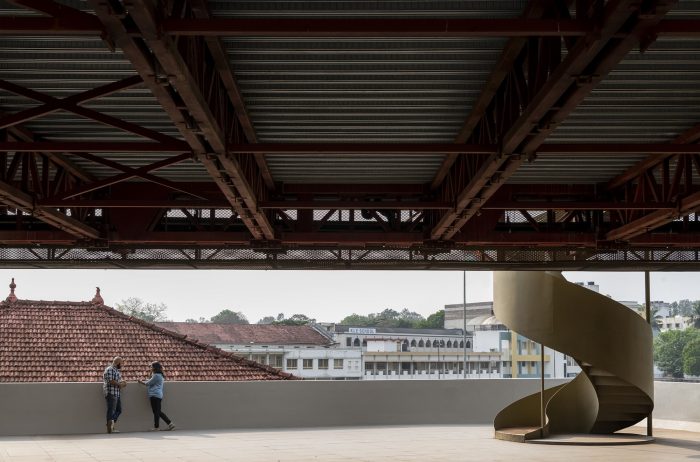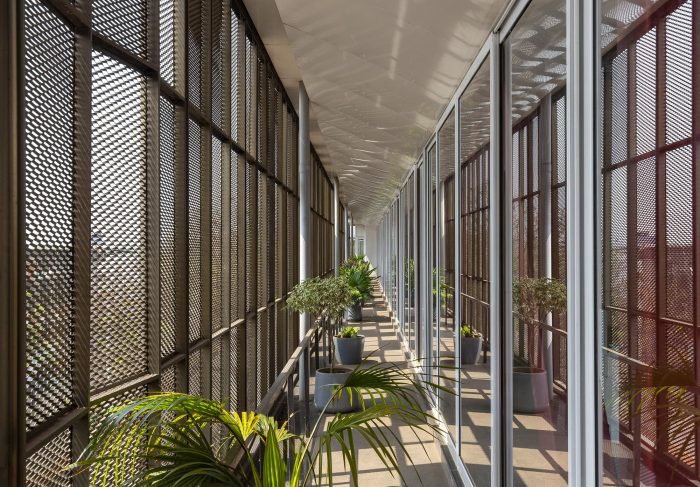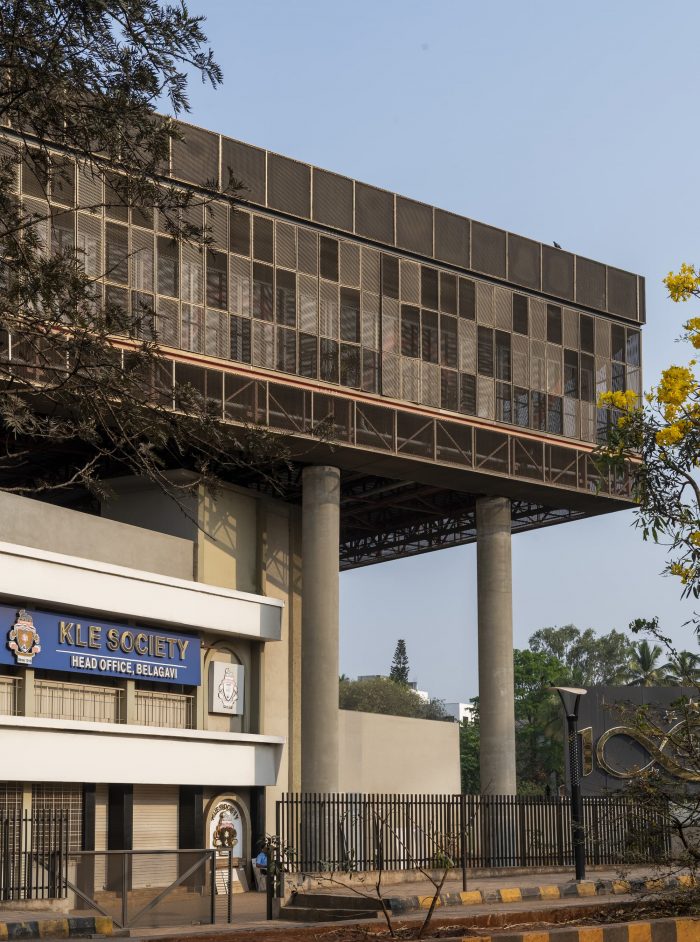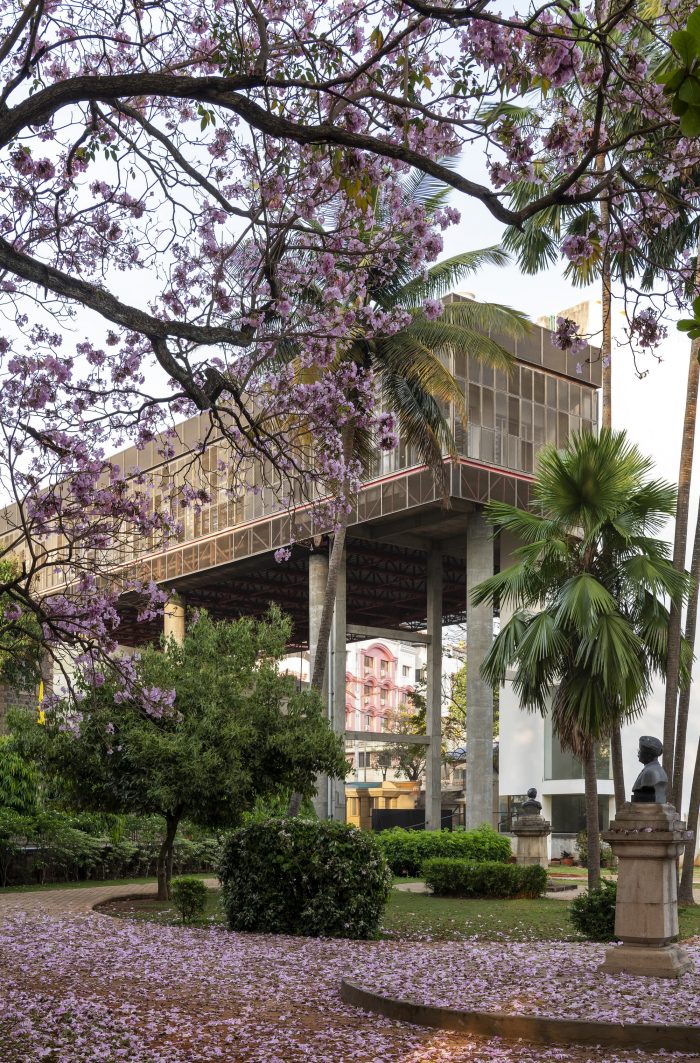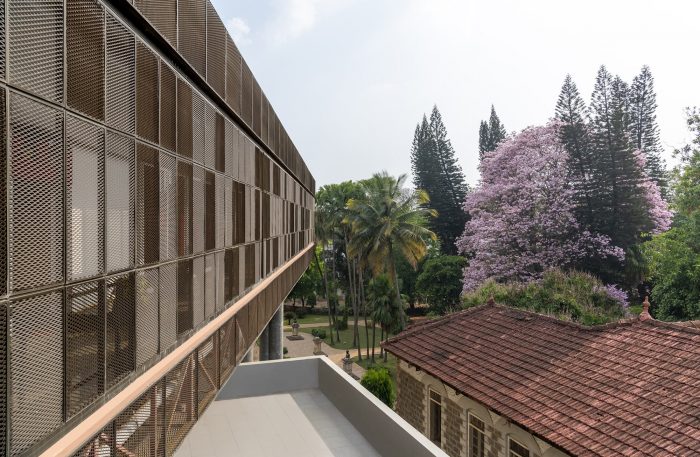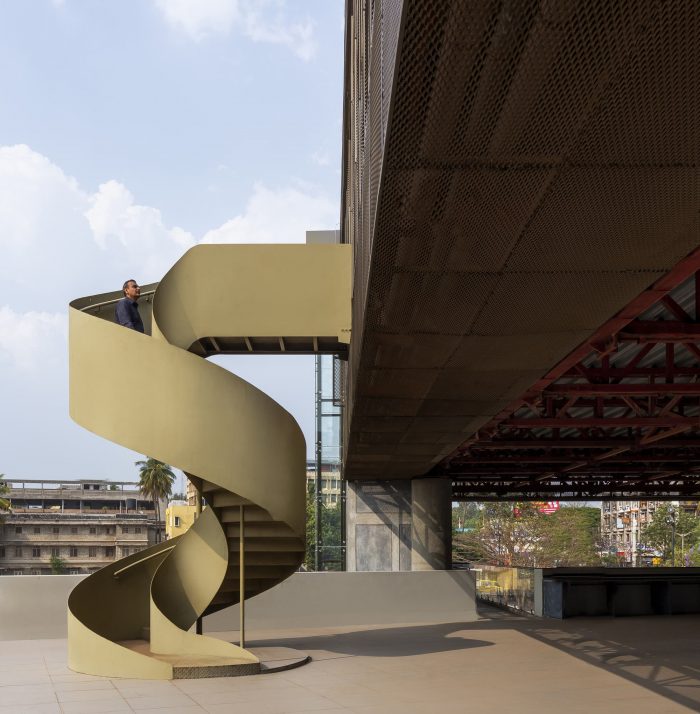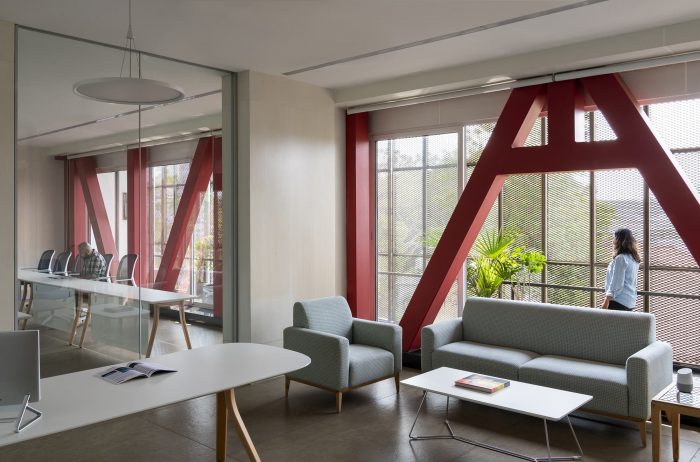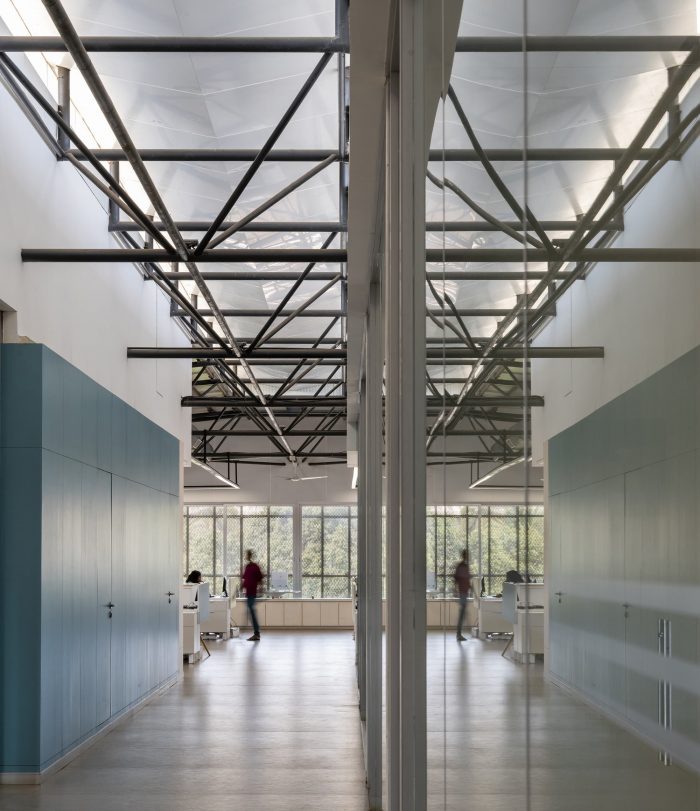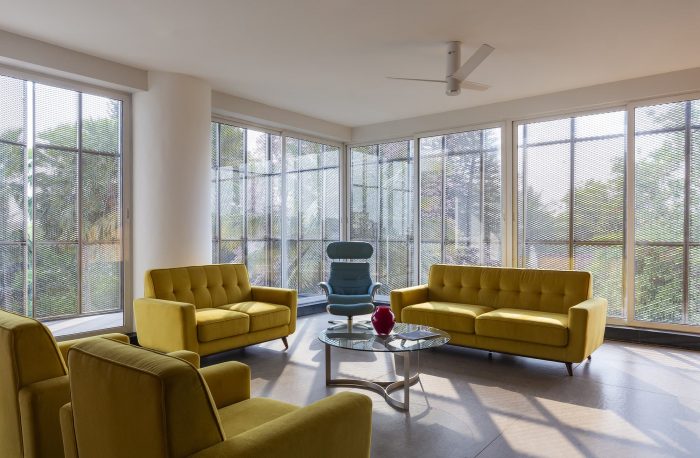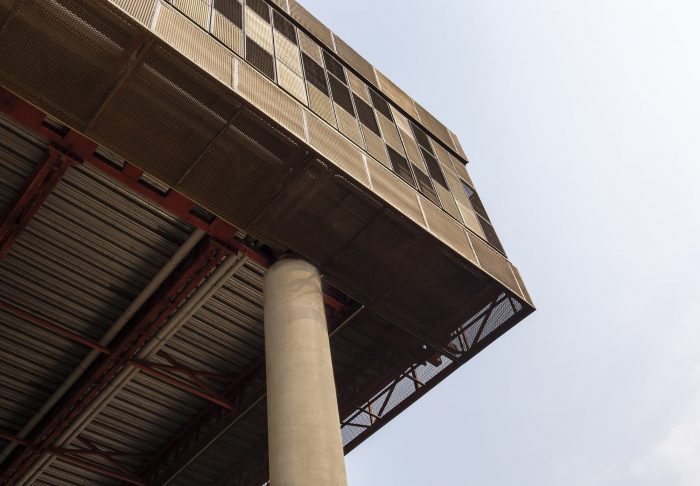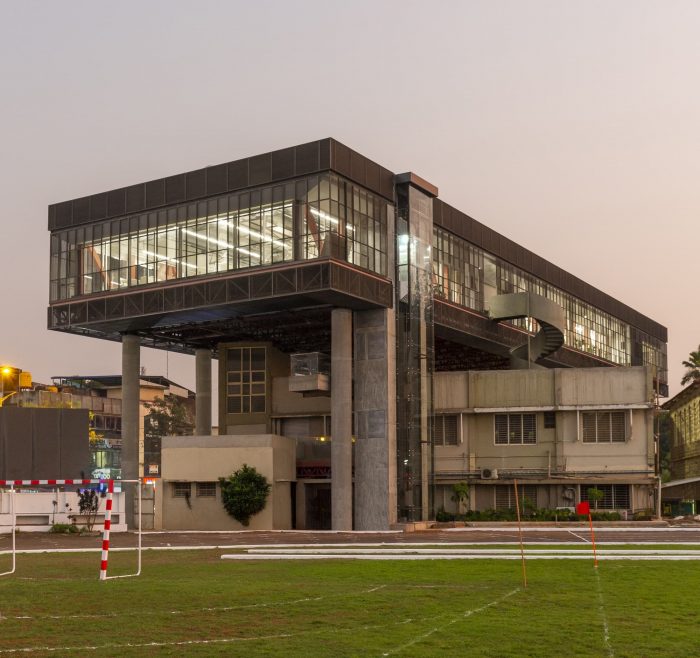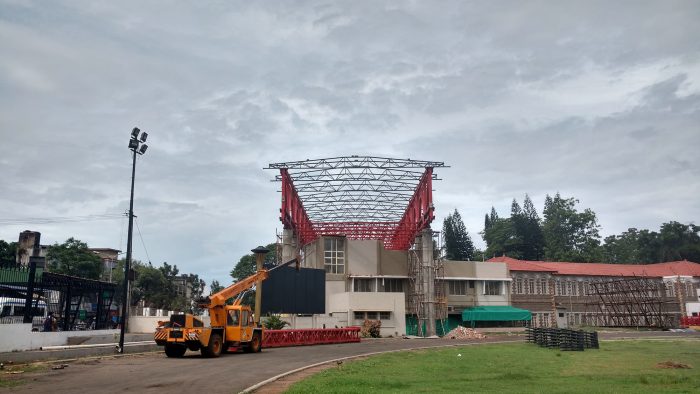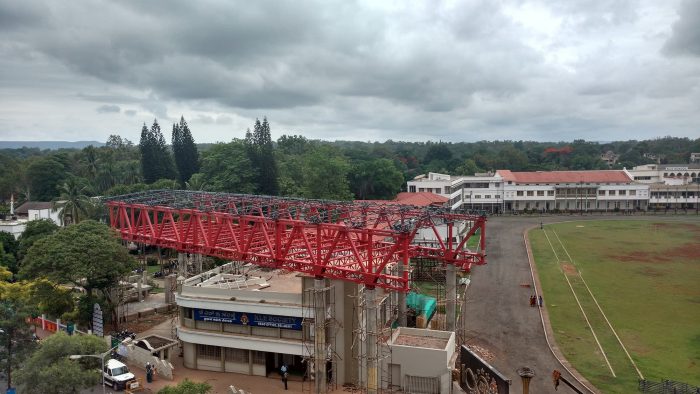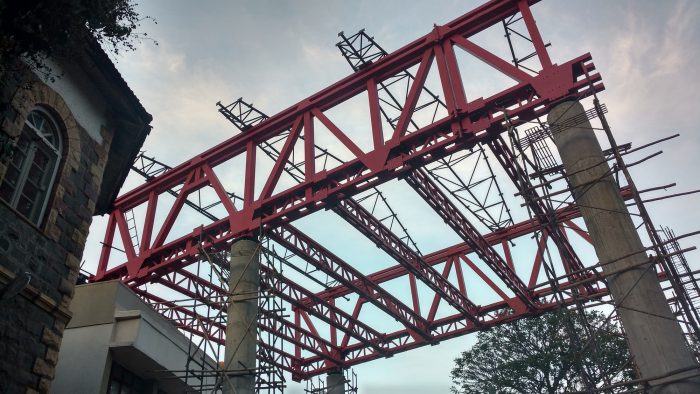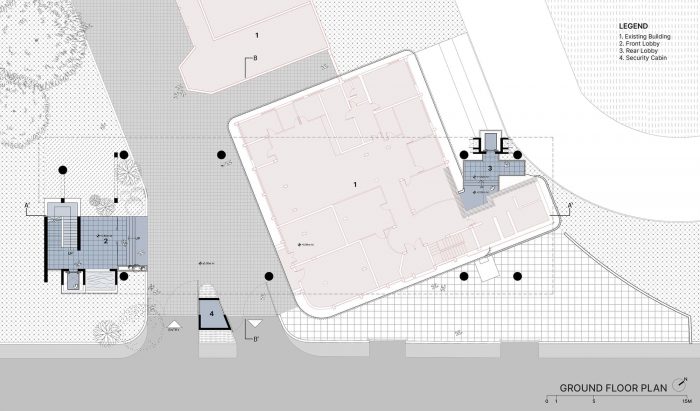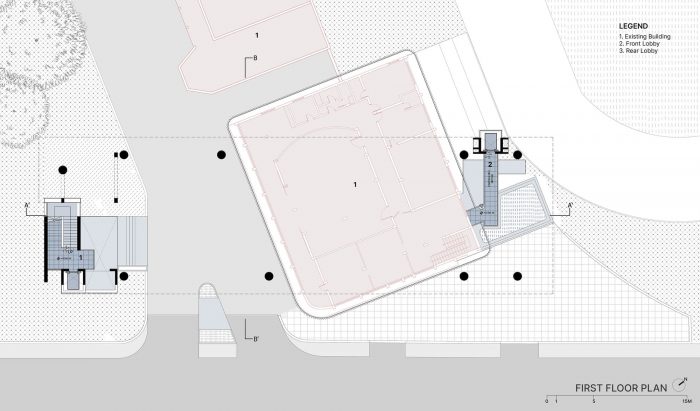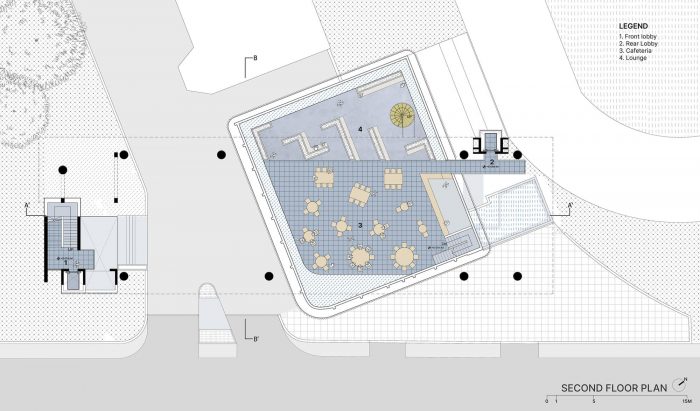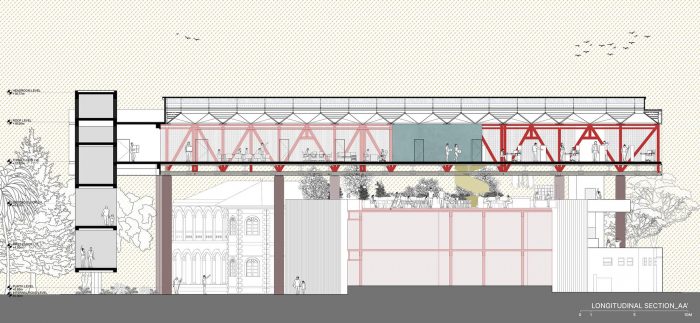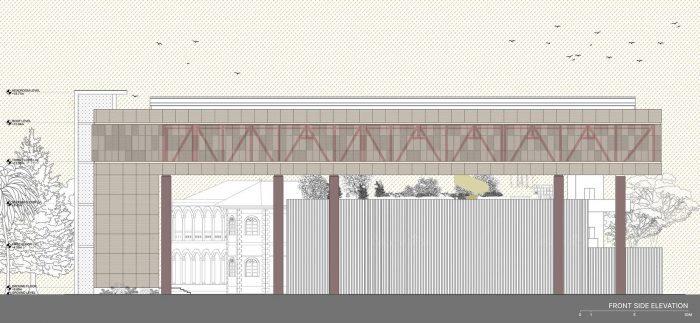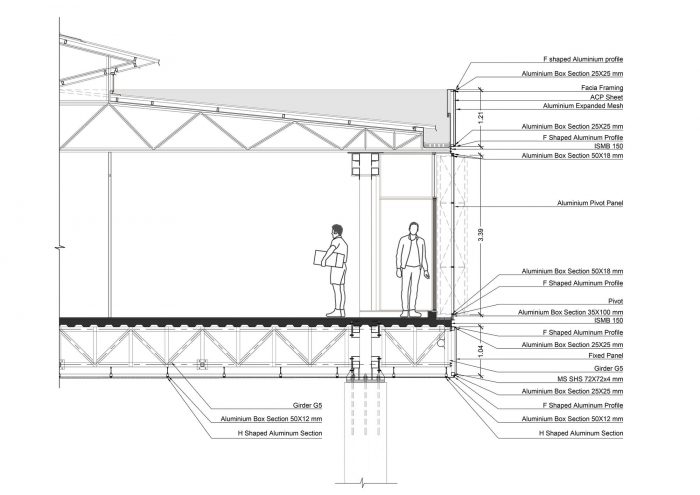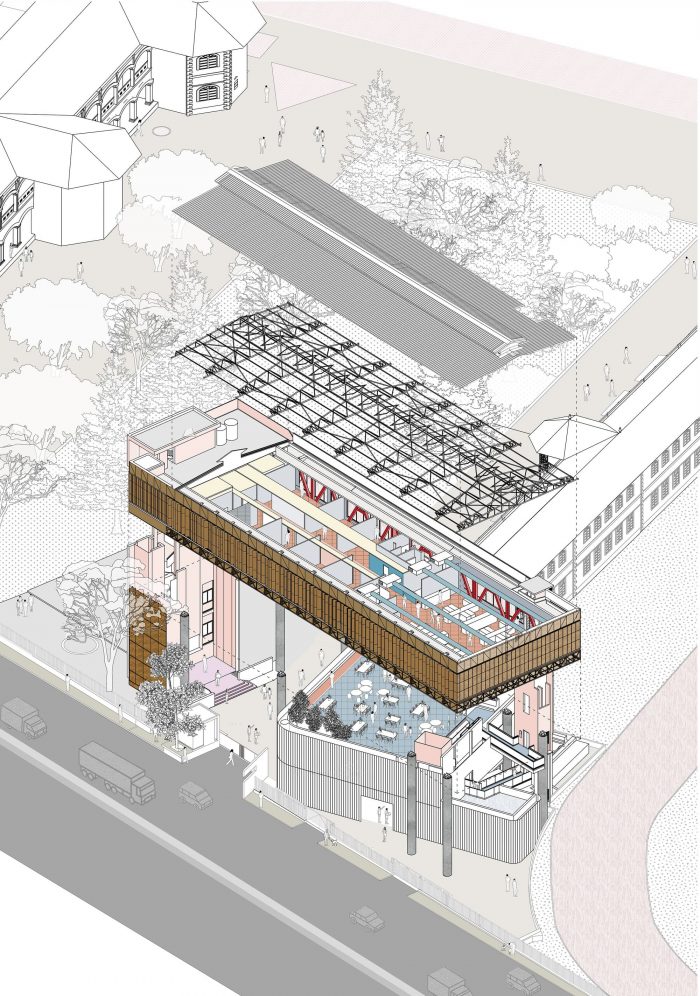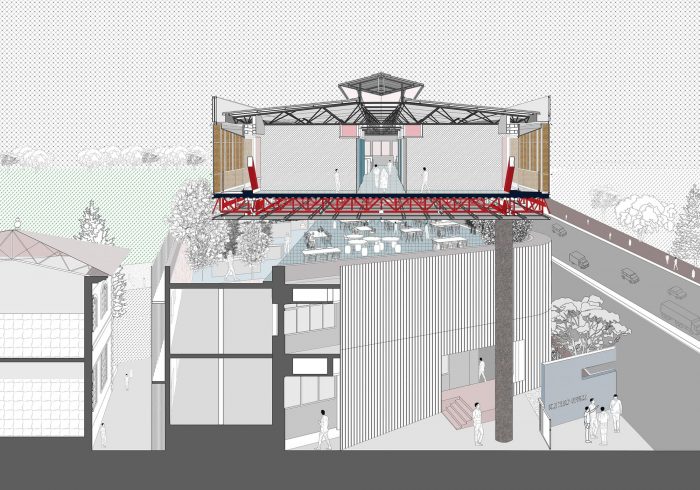一个现有的结构是否可以在不真正干扰它,甚至几乎不触及它的情况下进行扩展?新的东西如何与旧的东西进行协商,使它们各自保留自己的身份,但又能凝聚在一起?当一个著名的教育慈善机构需要为他们有50年历史的两层楼的公司办公室增加空间时,这些都是我们向自己提出的许多问题。现有的办公室虽然不显眼,但对该机构的集体记忆来说是一个重要的空间,出于历史感,我们希望保留它。办公室总是热闹非凡,并经历了一次中期改造,因此在顶部的任何增加都必须以不干扰或破坏办公室工作的方式进行。因此,我们面临的挑战是,如何在不影响现有办公室功能的情况下进行干预,也不因侵入性的结构工程而破坏其内部。
Could an existing structure be extended without really disturbing it or even barely touching it? How can the new negotiate with the old so that each retains their own identity and yet are cohesive together? These were among the many questions we asked ourselves when a reputed educational charity institution needed additional space for their 50-year-old, two-story corporate office. The existing office, though nondescript, was nevertheless a space that had significance to the Institution’s collective memory, and it was sought to be retained out of a sense of historicity. The offices were always bustling with activity and had undergone a mid-life retrofit, so any addition to the top would have to be done in a manner that did not disturb or disrupt the workings of the office. Therefore the challenge was to intervene in a manner that the existing office would not be affected in its functioning nor would its interiors be damaged through intrusive structural works.
几个背景–城市干道、母亲校园和运动场。
动脉。拟建的建筑需要对它的多种环境作出多种反应。一方面,虽然该建筑是一个占地100英亩的百年教育园区的一部分,但它位于贝拉加维市的一条重要干道上。这条路上的任何建筑都会在城市的视觉地图上占据重要位置。建筑物应该在这条城市的重要道路上建立起自己的视觉地标,这是设计大纲的要求。
校园。拟建的建筑也将是这个百年校园的正面之一,它标志着这个杰出的慈善组织的诞生和发展。园区是过去一个世纪建造的建筑的集合体,通过改造后的间隙景观松散地连接起来。由于树木的数量和现有建筑的低矮性质,该园区被城市视为一个非常长的围墙,几乎没有任何内部的景观。这是一个创造有意义的干预的机会,可以给校园一个可识别的身份。
运动场。校园的运动场与现有的总部大楼相邻,而现有的大楼在地面上几乎看不到,新的干预措施将成为地面边缘的一部分。就像建筑必须对这三种环境做出反应一样,建筑也将从这三个有利位置被观看。
Several contexts – The City Artery, Mother Campus, and Sports Field.
The Artery: The proposed building required multiple responses to its multiple contexts. On the one hand, the building, though being a part of a hundred-acre, century-old educational campus, was on an important arterial road in the city of Belagavi. Any building on this road would occupy an important place in the visual map of the city. It was a mandate of the brief that the building should establish itself as a visual landmark on this important road of the city.
The Campus: The proposed building would also be one of the frontages of the century-old campus which marked the birth and growth of this remarkable charity organization. The campus was a collection of buildings built over the past century, loosely connected by a retrofitted interstitial landscape. Because of the number of trees and the low-slung nature of the existing buildings, the campus was perceived by the city more as a very long perimeter wall with barely any views of the inside. This was an opportunity to create a meaningful intervention that could give the campus a recognizable identity.
The Sports Field: The sports field of the campus abutted the existing head-office building and whereas the existing building barely registered in the view from the ground, the new intervention would be a part of the peripheral edge of the ground. As much as the building had to respond to these three contexts, the building also would be viewed from these three vantage points.
战略–经过深入研究,设想了一个三方面的应对方案。该建筑不会仅仅是低层建筑的延伸/外露,而是可以成为一个漂浮在老建筑上几乎不接触地面的结构。这将是一个必须回应三个独立的微观背景的结构–面向场地的道路、内部的殖民时代的校园和邻近的校园运动场。由于消防规定,该结构被限制在15米的高度,其占地面积受到道路后退以及附近的建筑和地面的限制。建筑物的建设必须以不干扰现有校园功能的方式进行。
Strategy – After a deep study, a three-pronged response to the brief was envisaged: The building would not be a mere extension/extrusion of the lower floors, but rather could be a structure that floated above the old building barely touching the ground. This would be a structure that had to respond to three separate micro-contexts – the road fronting the site, the colonial-era campus within, and the adjacent campus sports field. The structure was restricted to a height of 15 m because of fire regulations, and its footprint was restricted by road setbacks as well as the buildings and the ground in its proximity. The building construction would have to happen in a manner that did not disturb the functioning of the existing campus.
决议–作为空间的结构。拟议的增建项目被认为是一个可以悬停在现有建筑上的空间,对地面的干扰很小–一个悬停空间。在最简单的情况下,该设计是在两个全层高度的边缘桁架之间的空间。这些桁架将被支撑在仅有的8个圆柱形RCC柱上,仔细定位以避免对地面的现有条件造成障碍。桁架外围的这八根柱子允许约1200平方米的无缝不间断的内部空间。顶部办公室的宽度受到现场现有环境的限制,以及考虑到整个内部的日光渗透。这个空间的长度同样受到一侧地面的限制,另一侧是现有的花园和一个具有历史意义的纪念馆。从立面上看,它是一个倒L形,垂直臂包含了流通和大厅,水平臂漂浮在旧建筑上,并悬垂在运动场上。形成L型的垂直循环也有助于在视觉上将建筑固定在一侧的地面上,同时允许它漂浮在另一侧的运动场背景中。建筑的L型创造了一个从道路到校园的入口,与中央的林荫大道保持一致,沿途有几个遗产建筑。当人们从道路上看校园时,这些文物建筑通过这个三层高的入口被框住了。
Resolution – Structure as Space: The proposed addition was thought of as a space that could hover over the existing building in a manner that creates little disturbance at the ground level – A Hover Space. At its simplest, the design is a space between two full-floor height edge trusses. These trusses would be supported on just 8 cylindrical RCC columns, carefully positioned to avoid creating obstacles to the existing conditions at the ground level. These eight columns at the periphery of the truss allowed a seamless uninterrupted interior space of around 1200 sq.m. The width of the office on top was restricted by the existing context on site as well as the considerations of daylight penetrating throughout the whole interior. The length of this space was similarly restricted by the ground on one side, and an existing garden with a historically significant memorial on the other. In elevation, it comes across as an inverted L form with a vertical arm containing the circulation and lobby and a horizontal arm that floats over the old building and cantilevers onto the sports field. The vertical circulation that forms the L form also helps visually anchor the building to the ground on one side, while allowing it to float in the background of the sports field on the other side. The L form of the building creates an entry portal from the road to the campus which aligns with the central tree-lined avenue along which there are several heritage structures. These heritage buildings are framed through this triple-height entry portal as one views the campus from the road.
阳台作为第二层皮肤。简单的无柱办公空间被一个连续的阳台包裹着。这个阳台是对次大陆殖民时期建筑的一个普遍特征的解释。阳台同时也是一个社会空间,它没有单一的功能,但可以有多种用途,同时也是一个被动的气候装置,可以保护室内免受亚热带地区恶劣的雨水和阳光的影响。在这里,这个连续的阳台是办公室的休息空间,也是室内外之间的气候缓冲区。地面高度的桁架被涂成深红色,成为一个雕塑般的元素,界定了核心办公空间和外面阳台之间的边缘。简单的铝制推拉门作为一个内部围护结构,使人们可以很容易地进入阳台。可操作的垂直翅片的膨胀网状铝皮进一步加强了阳台提供的气候和透明度控制,这些阳台位于较长的东部和西部外墙前面,从而过滤了这些外墙的刺眼的阳光。
Verandah as a second skin: The simple box of column-free office space is wrapped around with a continuous verandah. This verandah is an interpretation of one of the ubiquitous features of the colonial architecture of the subcontinent. A verandah is simultaneously a social space, which is undefined in a singular function but allows for a multiplicity of uses, as well as a passive climatic device that protects the interiors from the harsh rain and sun of the subtropics. This continuous verandah, here, is a breakout space for the offices as well as a climatic buffer between the interior and exterior. The floor-height trusses, painted in a deep red, become a sculptural element that defines the edge between the core office space and the verandah outside. Simple aluminum sliding doors act as an interior envelope allowing for easy access to the verandahs. An expanded mesh aluminum skin of operable vertical fins further enhances the climatic and transparency control offered by the verandahs that front the longer eastern and western facades thus filtering harsh direct sunlight on these facades.
通过桁架的形式以及简单的铝制玻璃窗、阳台上的植物和轻质铝网屏,从内部空间看到的外部景观是有层次的,有框架的。 因此,办公空间提供了一个远离城市喧嚣的避难所,但又通过层层的透明度将城市和校园过滤掉。办公室的内部空间受益于丰富的自然光和通风,简单的白色调和重点颜色与植物和树木的叶子使空间更加生动。内部空间按程序划分为三个主要空间–入口大厅和主席办公室,中间部分是私人办公室和会议室,后面部分是开放的办公隔间,可以看到城市和运动场的景色。屋顶桁架在许多地方被暴露出来,沿着屋顶中心的夹层天窗定义了一个脊柱,也强调了主要的流通走廊。
The views of the exterior from the interior spaces are layered and framed, by the form of the trusses as well as the simple aluminum glazed windows, the plants in the verandah, and the light aluminum mesh screen. Thus, the office spaces provide a sanctuary from the bustle of the city outside yet filter in the city and the campus through layers of transparency. The interior spaces of the offices benefit from the abundant natural light and ventilation and a simple palette of whites and accent colors with foliage of plants and trees enliven the space. The interior is programmatically divided into three main spaces – the entrance lobby with the Chairman’s chambers, a middle section with private offices and meeting rooms, and a rear section with open office cubicles with a view of the city and the sports field. The roof trusses are left exposed in many areas, and a clerestory skylight along the center of the roof defines a spine that also emphasizes the main circulation corridor.
间隙空间。从程序上讲,新增加的部分需要与现有建筑中的办公室连成一体。在视觉上和概念上,他们需要保持距离。这两个结构由一个面向运动场的玻璃电梯连接,当人们垂直穿过办公大楼时,可以看到校园和运动场的动态景观。玻璃电梯也是一个元素,它不仅在物理上连接了两座建筑,而且还允许用户暂时离开建筑,尽管是在一个玻璃盒子里,并重新连接到办公室里。这种既在建筑内又与建筑分离的交通仪式,进一步强调了新旧之间的区别。老建筑的露台成为一个中间空间,可以作为一个活动空间/庭园的功能。这个反空间在视觉上和程序上都充当了新旧之间的缓冲和暂停点。露台通过一个普通的狗腿楼梯从低层进入。现在它也有了一个雕塑般的环形楼梯,将它与上面的新建筑连接起来。新的加建部分相对于旧的加建部分的位置产生了这样一种情况:露台的一部分向天空开放,而另一部分则被上方的悬停空间所覆盖。
Interstitial Space: Programmatically the new addition was required to function in cohesion with the offices in the existing building. Visually and conceptually, they needed to be distanced. The two structures are connected by a glass elevator facing the sports field, which provides dynamic vistas of the campus and its sports ground as one travels vertically through the office complex. The glass elevator is also an element that not only connects the two buildings physically but also allows a user to temporarily exit the buildings albeit in a glass box and reconnect back to the offices. This ritual of being transported while being in the building yet being apart from it, further emphasizes the distinction between the old and new. The terrace of the old building becomes an interstitial space that can function as an event space/terrace garden. This anti-space acts as a buffer and a pause point, visually as well as programmatically, between the old and the new. The terrace had access from the lower floors through a regular dog-legged staircase. It now also gets a sculptural circular staircase that connects it with the new addition above. The placement of the new addition with respect to the old one generates a condition where parts of the terrace are open to the sky and a part of it is covered by the hovering space above.
几个反应。新增加的部分,虽然看起来是一个简单的金属盒子,但它的结构中交织着几层的复杂性。它对道路的回应是作为一个与道路平行的线性屏蔽盒出现,并通过树叶来体验。它形成了一个通往校园的门户入口。它也被视为运动场和跑道的背景,成为校园的一个视觉锚。总的来说,新的办公空间为该组织提供了一个新的身份和存在,同时也为更大的校园创造了一个入口的感觉。这些办公室结合了私人房间和开放的工作桌,极大地受益于外部的阳台,这些阳台为室内提供了恶劣的户外环境。在它的几个细微差别和细节中,设计通过简单的策略解决了几个功能、环境和气候参数。
Several responses: The new addition, though appearing to be a simple metal box, has several layers of complexity woven into its very fabric. It responds to the road by appearing as a linear screened box that is set parallel to the road and is experienced through the foliage. It forms a portal entranceway to the campus beyond. It also is experienced as a backdrop to the sports ground and track acting as a visual anchor for the campus. Overall, the new office space created has given a new identity and presence to the organization as well as created a sense of an entry portal for the larger campus. The offices with their combination of private chambers and open work desks vastly benefit from the exterior verandahs which shelter the interiors from the harsh outdoors. In its several nuances and details, the design addresses several functional, contextual, and climatic parameters through simple strategies.
Architects: Thirdspace Architecture Studio
Area : 1200 m²
Year : 2020
Photographs :Suryan // Dang
Lead Architect : Praveen Bavadekar
Structural Design : D.L.Kulkarni Associates, Dileep Kulkarni
City : Belagavi
Country : India

